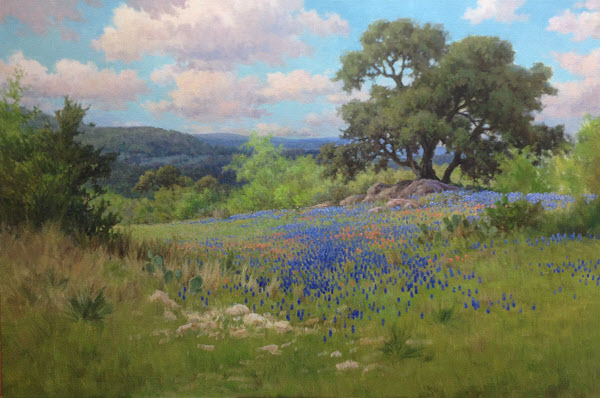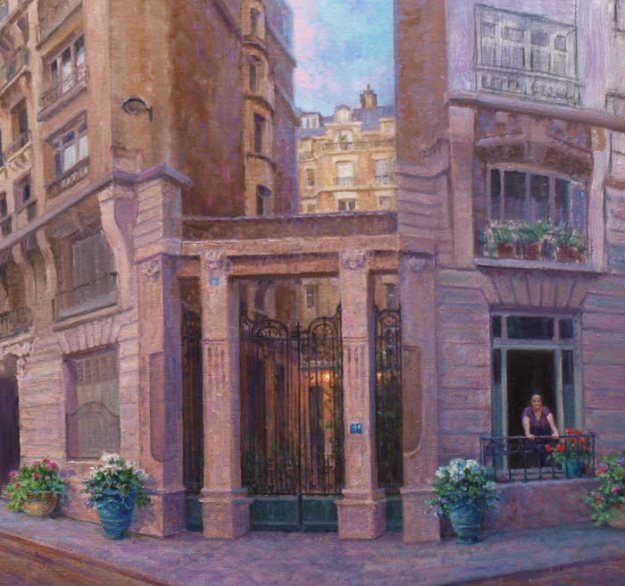How to paint bluebonnets is the the focus here in part 4 of my oil painting demo series of posts on painting a Texas bluebonnet landscape.
First, I want to show the completed painting. This will give you an idea of where the painting is going. Click on the image for a larger view.

I set the stage for the bluebonnets by putting in the grasses working from back to front. I darken the values as I come forward.

Next I work to cover the rest of the canvas. I’m not focusing heavily on details at this point, just getting my under-painting done. For some of the textures of the grasses I like to use an old jagged edged bristle fan brush.

After the paint dries I then move on to massing in the bluebonnets with a dark value of blue based off of Ultramarine. I departed somewhat in my traditional mixture by adding Indanthrene Blue by Winsor & Newton into the mix. Since bluebonnets lean towards blue violet I also add in some Dioxine Purple or add Permanent Rose or Alizarin for variety.

I continue with my dark mix for the bluebonnets, working out a pattern that leads the eye back into the painting.

After this layer dries I start adding lighter values for the bluebonnets working from the back to front.

Here’s a detail of the bluebonnets.

Another up close view of the painted bluebonnets.

Once I finished all the bluebonnets I proceeded to other areas of the painting that needed the finish work such as the big tree, rocks, and cactus and a little bit of cutting back into the bluebonnets here and there with the grass color. I wanted to make sure they didn’t look as though they were floating and make the pattern more pleasing and believable.
The following are up close sections so you can see more of the finished detail. As you can see I’ve kept tight detail to a minimum. However, due to the size of the painting it looks more detailed than it really is. I first finish the pattern of the foliage with light dark and middle values. Then I add tree limbs. When dry I negative shape paint the sky holes, chiseling out the forms of limbs and further modifying the shape of the tree.

Another patch of completed bluebonnets and surrounding vegetation and rocks.

Detail of the middle ground cactus.

Here’s the cactus in the foreground. Here you can see some individual bluebonnets scattered around although not haphazardly. I’m keeping my design in mind. These bluebonnets are a supportive role to the larger masses. Again on the topic of how to paint bluebonnets, notice how the bluebonnets have a dark value, followed by a lighter value and finally a white cap on top. It gives the flowers depth. Also some of the cactus stickers are hinted at. However, in the above image I have not added them except for a few catching the light. Why? They’re further away and your eye would not pick up that kind of detail. Plus the amount of detail has to be in proportion to the rest of the details in the painting. In other words, if your painting is more impressionistic would it make sense to add a bunch of tight detail on an object and leave the rest loosely painted. This might work on a close up view and keeping a background simple, but remember to keep your overall painting in mind and don’t get caught up in rendering details and loose focus on the whole. Every section has to relate to the other.

Below is a detail section of rocks. Remember a rock is a shape. It has sides and how the rock is positioned in relation to the light you will have different values. If only two sides are visible you will have a a light and shadow area. The same is true if you can see three sides, but you will have three values at a minimum. Light, mid value and shadow. Don’t put your sunlight colors in areas that are to be in shadow or put shadow colors in areas that are in the light. Colors in the light are warmer, those in shadow are cooler, but sometimes they can appear somewhat warmer due to a warm reflected light bouncing off other warm colored rocks in sunshine. You learn to paint rocks by studying them. No good substitute for observing them and paying attention to how the light describes their form.

Here’s the detail area of the tree on the left and a view of the distant hills and lower sky. In painting the tree the sequence is establish the foliage first, them indicate limb structure and finally paint in the negative shapes on the sides of the limbs and other sky holes keeping in mind what’s in behind the tree. Often you will have to paint those values a little darker since they can appear to be stuck on top of the tree instead of being behind it. You can also modify the sky hole a little by overlapping it with some tree foliage.

And finally here’s another close up view of the clouds in the right hand corner area. Again like any other shape a cloud has form to it and as such is subject to having light and shadow sides. Best way to learn to paint clouds is by actually studying them.

I hope that these series of posts will benefit you in your own painting. Have fun learning!















































